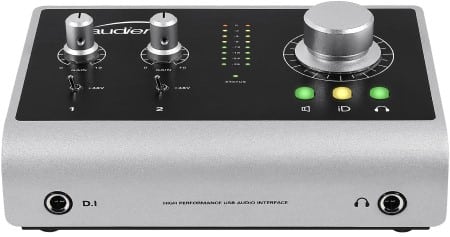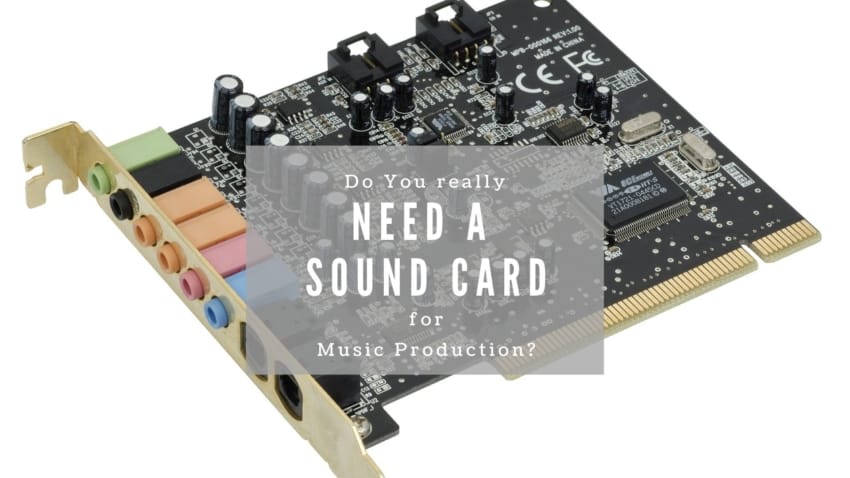Last updated on February 12th, 2021 at 01:17 pm
When I was in my early teens, I decided that I wanted to start recording my guitar on top of some backing tracks, however I didn’t have an Audio Interface and I also couldn’t afford one.
I then realized that my computer had a sound card already built in and that I should be able to use it to record music.
After going to my local music store and asking how I could do this, I managed to make it work.
Now, this is completely fine to do if you’re just starting out and want to know what it feels like to record music, but it’s far from the best solution you can get.
Many people wonder if they need a sound card for music production or if they should get an Audio Interface.
So, now that I know a thing or two about recording music at home properly, I’m going to give you a definitive answer to this question.
Read also: Recommended Computer Specifications for Music Production.
Let’s get started.
Do I need a sound card for music production?
What you really need is an Audio Interface, which essentially is a sound card that just offers more inputs and outputs as well as a much better sound quality.
Your computer’s built-in sound card won’t be enough for producing music because you can’t connect as many microphones, instruments, etc., plus the audio quality won’t be anywhere near as good.
Recording with just the built-in sound card is definitely possible, but there can be latency issues, you can only use one input at a time, and the sound quality is pretty bad when compared to what you can get out of a quality interface.
Of course, if you have no other choice but to use the built-in sound card to record, then by all means, try that!
Moving on…
Is a sound card the same as an audio interface?
An Audio Interface and a Sound Card do essentially the same thing, which is convert an analog signal into a digital one so that it can be recorded by your computer.
The main difference lies in that a regular sound card offers minimal I/O and worse sound quality, which isn’t ideal for recording music.
Dedicated Audio Interfaces, like the ones you see in most professional- and also home music studios, are designed to provide superior audio quality while at the same time offering more Inputs and Outputs and other features as well, such as direct monitoring, MIDI I/O, and some even have built-in amp simulation and effects.

Now, it is possible to record music using just the built-in sound card that comes with your computer:
You can connect a microphone or instrument to the microphone/line-in jacks respectively (only one at a time) and record that way.
This works surprisingly well, but the sound quality won’t be anywhere near as good as what you can get out of a dedicated audio interface, even the cheaper ones.
Additionally, latency can actually be quite the issue when recording with the built-in sound card, which of course is far from ideal when trying to produce music.
If you are serious about music production, then you should get an Audio Interface, no questions asked.
If you are just starting out, on the other hand, especially if you want to record some electric guitar or bass using either electric guitar amp sims or bass amp sims, you could start out by connecting your instrument to the line-in jack to record using those plugins.
Now, here’s another very common question I see being asked everywhere.
Is a sound card the same as a DAC?
A sound card consists of a DAC (Digital to Analog Converter) and an Amp.
A DAC takes the digital audio data and transforms it into an analog audio signal so that it can be reproduced by the speakers later on.
After the digital to analog conversion and before reaching the speakers, the signal is sent through a preamp and then to an Amp to be amplified to an appropriate level.
So, essentially, a sound card has a DAC built in, but it also amplifies that signal so that it can be properly reproduced by the speakers.
As far as music production goes, if you invest in a good DAC, the better off you will be.
This is mainly because a good DAC will reproduce the sounds with much higher fidelity.
When listening to regular music, watching movies, playing video games, etc., there’s no real need to having an expensive DAC, but for music production you need as clean of a signal as possible, and this is where a high-quality DAC can actually help.
What is a good Audio Interface for Beginners?

This is a highly debated topic since there isn’t just one right answer.
The most important thing to consider when purchasing an audio interface is knowing what you’re going to use it for, since recording just vocals or guitar on top of a backing track is completely different from recording a drum set, an ensemble, or anything that requires a large number of inputs.
The number of inputs the interface offers is absolutely essential; however, in most cases, especially as far as home recording goes, you don’t really need too many for the simple fact that you will probably be recording by yourself.
In this case, two inputs should be enough.
Now, getting an interface with a higher channel count will usually cost more as well, which is also a good reason to get one with just two inputs.
Also pay attention to the MIDI I/O, since most audio interfaces don’t feature a MIDI connection.
You can still connect your MIDI device via USB, but it’s always a plus to have those connections on your interface.
So, figure out what your needs are and then decide which one to buy.
I have written many posts comparing some of the most popular budget audio interfaces out there, as well as some other interfaces that, despite being pricier, are way better in every way.
Here is a quick list of those posts;
- Behringer UM2 vs UMC22 (One Input Interfaces)
- Scarlett 2i2 VS UMC204HD (2 Input Interfaces)
- Apollo Twin MKII VS Audient iD14 (2 Input Interfaces, Higher quality)
- Scarlett 6i6 VS UMC4040HD (4-6 input Interfaces)
Note: The Scarlett 6i6 features 6 inputs but only two of those are combi XLR ones.
My personal favorite, and the one that I have at home, is the Audient iD14.
This one sounds absolutely amazing and the DI input, which is used to connect electric guitars and basses directly to the interface, is one of the best-sounding ones I’ve ever used.
Top 5 Audio Interfaces for Beginners
| Name | Description | Price |
| Behringer UMC 204HD | 2×4 interface, MIDI I/O, and excellent for the price. | Amazon |
| Focusrite Scarlett 2i2 | 2×2 interface, no MIDI, great sound quality. | Amazon |
| Behringer UMC404HD | 4×4 interface, MIDI I/O, most cost efficient interface of all. | Amazon |
| Audient iD14 | 2×2 interface, no MIDI, best audio quality, can be expanded to 10 inputs. | Amazon |
| Audient iD4 | 2×2 interface (1 mic, 1 instr), no MIDI, excellent sound quality. | Ama |
Conclusion
While a sound card essentially does the same thing as an audio interface (Analog-to-digital and digital-to-analog conversion), they are two completely different beasts and serve a different purpose.
In order to produce high-quality music, you will need to purchase an Audio Interface, even better if you can get your hands on one with decent preamps, like the Audient ones or the Apollo MKII series.
Sure, you could connect your guitar, bass, or even microphone to the 3.5mm jacks of your sound card and record that way, but this is far from ideal and will yield less than optimal results.
So, for music production, get an Audio Interface!
I hope this information was useful.
Have a wonderful day!
